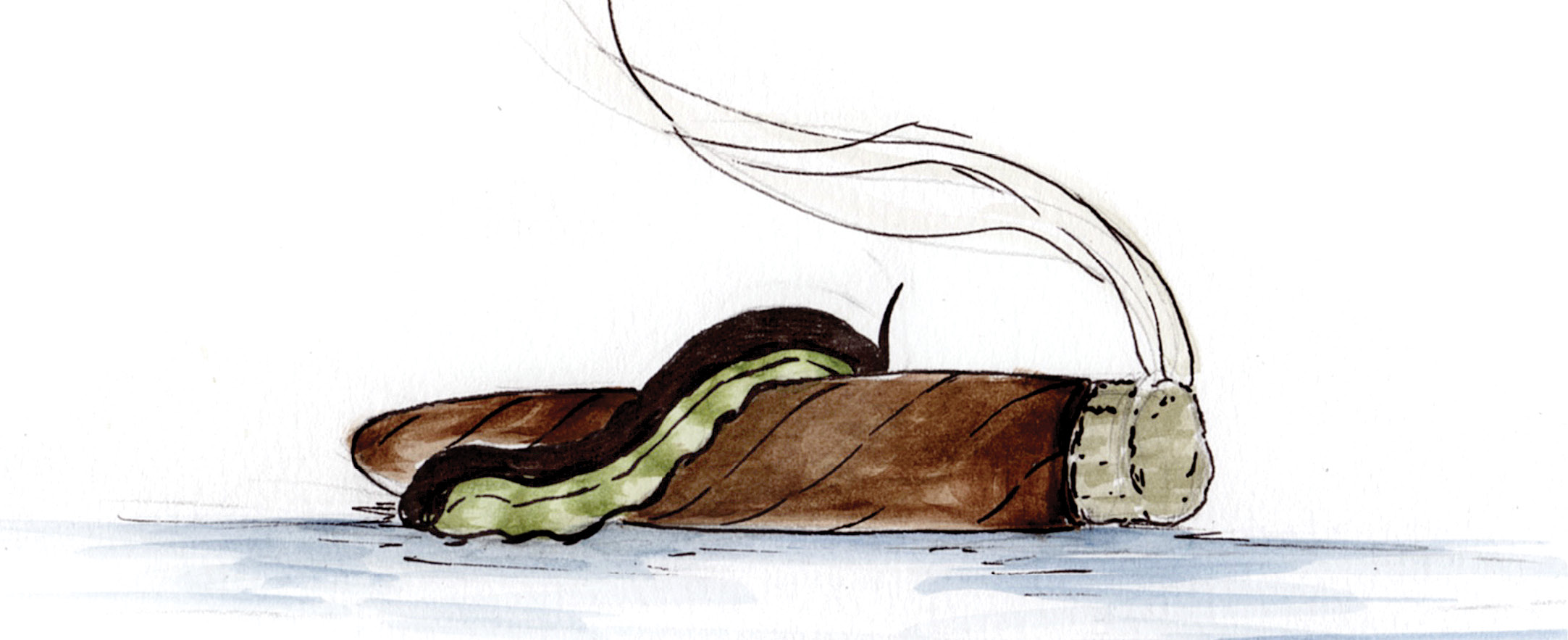
By Harold Chambliss
I like good cigars and always enjoy the cigar reviews and rankings by the cigar magazines. In a recent issue of Cigar Aficionado, here’s what they had to say about the Arturo Fuente Don Carlos No. 2. “This reddish-colored torpedo burns and draws superbly, balancing nut and cocoa flavor with a touch of red pepper spice and sweet cedar. Price: $12.60.”
Now, my palate is not sophisticated enough to recognize cocoa, red pepper or sweet cedar when it’s on fire, but I do know what smokes well and is pleasing to my tastebuds. In fact, I’m somewhat of an aficionado myself when it comes to wild-growing “Indian cigars,” due to my vast experience as a kid who tended to try almost anything at least once.
If you’re a fisherman, you may know something about Catawba trees (Catalba if you’re a Northerner). Growing up in the Deep South as kids akin to Huckleberry Finn, Tom Sawyer and the Little Rascals, we were introduced to the Catawba tree as a source for fish bait. Big, fat Catawba worms could be found on the green leaves of Catawba trees that grew around fishponds. My daddy owned a fishpond in Wildfork, Ala., named after himself, called Lake Lump. (I still miss him.) You might not think that’s very sophisticated until you realize he always fished in a dress shirt and tie at the end of a workday. Hey, the old-time golfers dressed that way, too. Look it up.
But, even though my pals and I always had a good supply of Catawba worms for fishing, the most amazing thing was that the seedpods that grew on the Catawba trees doubled as cigars. When they dried out, they looked like long, narrow, black cigars, so we did the logical thing — we lit ’em up and smoked ’em. They were a lot cheaper than real cigars at the time, which could cost as much as 30 or 40 cents if you bought a brand name, such as Swisher Sweets, which we did when we were flush. Maybe it was 30 cents for a package of five, come to think of it. Anyway, we always had our cigars and our fish bait. In truth, they weren’t what you’d call delicious, and they wouldn’t stay lit — the cigars, not the worms. 
Now the Catawba worms (getting back to fishing) on one particular late afternoon provided us with the highlight of all our activities for that entire summer. Sam Morton and Robert Lewis were fishing the shady, west side, log-laden spillway in my daddy’s home-built Georgiana Whaler (no Boston Whalers in Butler County) when Robert, trying to light his Swisher Sweet, knocked their bucket of Catawba worms into the water. Before they could scoop any up, the water started churning, and within about a minute there were fish jumping and literally turning flips in a sort of fish Olympics to get at those big, fat worms. The fish won, and my buddies didn’t save a single worm. However, the bass and bream had given away their positions — big tactical mistake. I use the word tactical because we always fished in our Army surplus stuff, including helmet liners, and everything was a military operation, being as World War II heroics were still fresh in our underused minds. So we reloaded from the Catawba tree and attacked their position from the bank and caught more fish than any of us had ever seen. Sam, in spite of stepping on a python and screaming things we’d only seen written on the L&N Railroad underpass, caught nine good-size bream and a 6-pound bass, all in a little more than 20 minutes. (Actually, Sam’s python was just an overgrown water snake, but Sam’s reaction was based on a python.) Robert caught six or seven bream and one bass. I caught four bream and a turtle that had joined in the Catawba banquet. I threw him back, but not until he nipped off the end of my thumb — my first experience with catch and high-speed release.
Once more, back to cigars: Here’s how Sam, who has a great memory, writes up an Indian cigar in Cigar Aficionado terms. The Lake Lump 1956 Lonsdale 6.5 x 18 (ring size). Price: Free. “An easy-drawing cigar if you don’t mind your cheeks caving in as you try to keep it lit. Somewhat of a roasted frog aroma at first, followed by manly overtones of burning BF Goodrich tractor tires. The finish is superb, especially when you get through throwing up and get back to fishing.” Sam also added (but not for publication) that, “All in all, this particular cigar provided a fascinating experience accompanied by dizziness, shortness of breath and guilt” — knowing Miss Anne (Sam’s mama) made it quite clear that if she caught him smoking he would have to give up fishing, camping out and hanging out with me, Robert and Rabbit Rowell, another pal who missed this particular adventure. Oh, now I’m reminded of rabbit tobacco, which also grew wild in our neck of the woods, but that’s another story, except for this bit of inside information: Rabbit tobacco was for chewing or smoking wrapped in newspaper or the Saturday Evening Post paper stock. Rabbit tobacco had more to do with baseball or hunting. But for now, let’s not take anything away from Indian cigars, fishing and the adventures of good boyhood friends who need to get together soon, wet a hook and try those Arturo Fuente Don Carlos No. 2s. And as they used to tell us in the Army, smoke ’em if you got ’em, gentlemen.
Harold Chambliss is a freelance writer living in Atlanta, a native Alabamian and a graduate of the University of Alabama. He has been published in the Oxford American and is a regular contributor to Tailgater Magazine.
